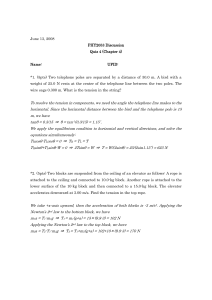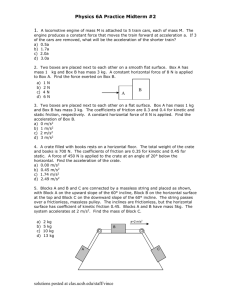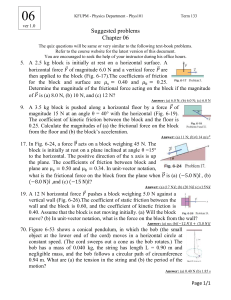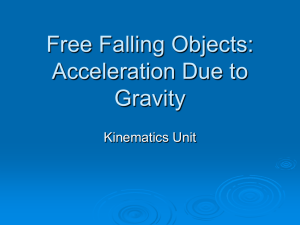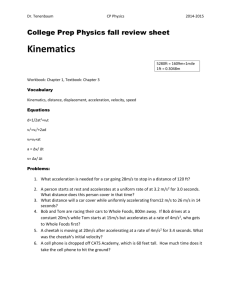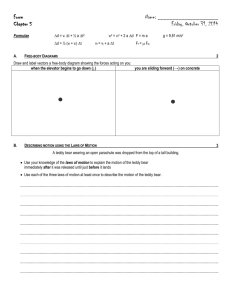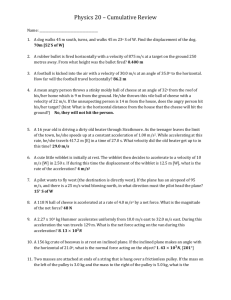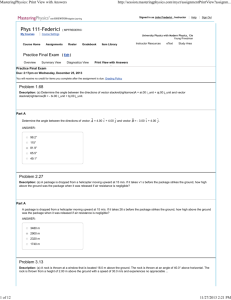Name: Date
advertisement
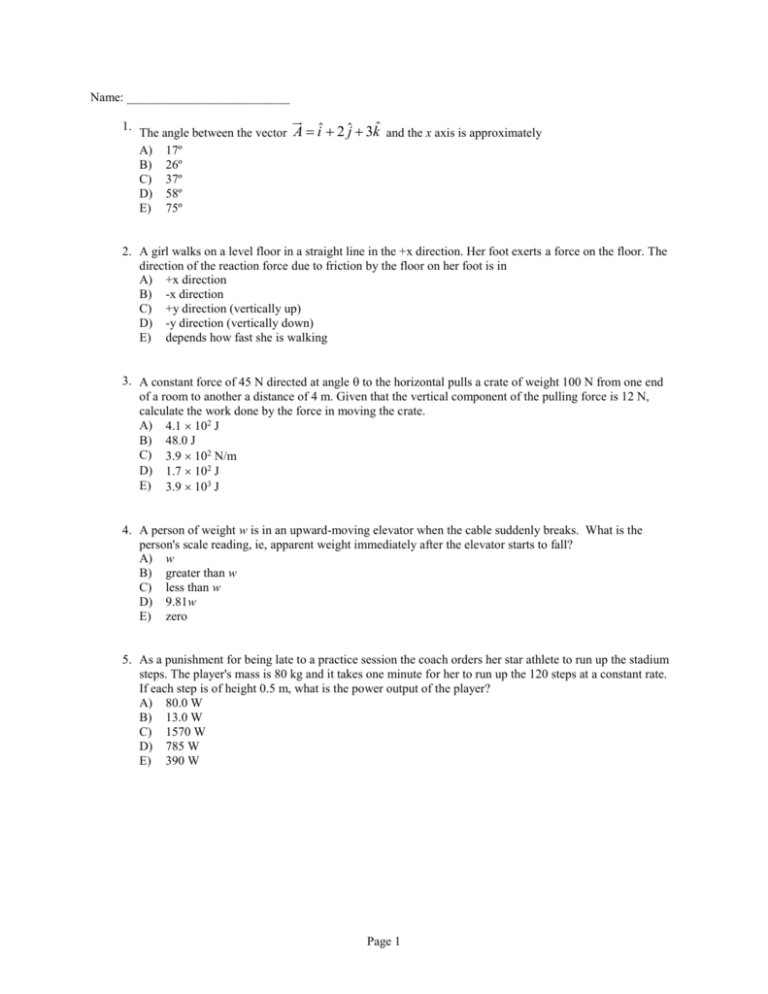
Name: __________________________ 1. The angle between the vector A iˆ 2 ˆj 3kˆ and the x axis is approximately A) 17º B) 26º C) 37º D) 58º E) 75º 2. A girl walks on a level floor in a straight line in the +x direction. Her foot exerts a force on the floor. The direction of the reaction force due to friction by the floor on her foot is in A) +x direction B) -x direction C) +y direction (vertically up) D) -y direction (vertically down) E) depends how fast she is walking 3. A constant force of 45 N directed at angle to the horizontal pulls a crate of weight 100 N from one end of a room to another a distance of 4 m. Given that the vertical component of the pulling force is 12 N, calculate the work done by the force in moving the crate. A) 4.1 102 J B) 48.0 J C) 3.9 102 N/m D) 1.7 102 J E) 3.9 103 J 4. A person of weight w is in an upward-moving elevator when the cable suddenly breaks. What is the person's scale reading, ie, apparent weight immediately after the elevator starts to fall? A) w B) greater than w C) less than w D) 9.81w E) zero 5. As a punishment for being late to a practice session the coach orders her star athlete to run up the stadium steps. The player's mass is 80 kg and it takes one minute for her to run up the 120 steps at a constant rate. If each step is of height 0.5 m, what is the power output of the player? A) 80.0 W B) 13.0 W C) 1570 W D) 785 W E) 390 W Page 1 6. A block slides down a frictionless incline. The path at the bottom of the incline is an arc of a circle. The direction of the net force on the block at the bottom of the arc (point P) is along (use the compass rose) A) B) C) D) E) (a) (b) (c) (d) (e) 7. Three forces F1, F2 and F3 act on an object. If F1 = 3N i + 5N j + 7N k, F2 = –5N i – 2N j –2N k, and the object is moving at constant velocity then the vector force F3 is A) –2N i – 3N j – 5N k B) 2N i – 3N j – 5N k C) 2N i + 3N j – 5N k D) –8N i – 7N j – 9N k E) 8N i + 7 N j +9N k 8. A box sits on an inclined plane without sliding. As the angle of inclination increases, the normal force A) increases. B) decreases. C) does not change. D) is directed upward. E) is directed in the direction of the gravitational force. 9. Spiral springs A and B are identical. When a weight of 12 N is fastened to the hook on A, the hook is lowered 2 cm. If a weight of 18 N is fastened to the hook on B, that hook is lowered A) 8 cm B) 6 cm C) 3 cm D) 4 cm E) 5 cm 10. A force F produces an acceleration a on an object of mass m. A force 3F is exerted on a second object, and an acceleration 8a results. What is the mass of the second object? A) 3m B) 9m C) 24m D) (3/8)m E) (8/3)m Page 2 11. (SHOW ALL WORK) A 1 kg mass is released from a height 102 cm from the right-hand side of the track shown in the diagram at right. Friction acts only along the horizontal portion 30 cm on either side of the midpoint O with a kinetic coefficient of friction of k = 0.4. Take the gravitational potential energy to be zero along the horizontal portion. A) The initial potential energy is B) The kinetic energy of the mass as it enters the horizontal portion for the first time is C) Mechanical energy converted to heat by friction during passage through the horizontal section is D) How high does the mass rise on the left-hand side? NAME_____________________________________ Page 3 12. (SHOW ALL WORK) A 10-kg box is pushed up a plane inclined at 30º with the horizontal. The box starts from rest and is pushed 5 m along the incline with a uniform acceleration of 2 m/s 2. The coefficient of kinetic friction is 0.20 and the pushing force is parallel to the plane. A) The numerical increase in the potential energy of the box is B) The numerical change in kinetic energy is C) The magnitude of the normal force exerted by the incline on the box is D) The numerical size of the friction force is NAME____________________________________ Page 4 Answer Key 1. 2. 3. 4. 5. 6. 7. 8. 9. 10. E A D E D A B B C D A·i=1=A·1·cosθ=√(12+22+32) ·cosθ , cosθ=.267, θ=75 o +x direction Fx=√(452-122)=43.37N, (43.37N)(4m)=174J zero h=120(.5m)=60m, 80kg(9.81m/s2)(60m)/60s=785W centripetal (a) F3=-F1-F2=(-3+5)i+(-5+2)j+(-7+2)k=(2i-3j-5k)N horizontal→weight, vertical→zero, thus decreases 12N=k·2cm, k=6N/cm, 18N=(6N/cm)x, x=3cm F=ma thus m=F/a, 3F=M(8a), thus M=3F/8a=3m/8 11. A. B. C. D. (1kg)(9.81m/s2)(1.02m)=10J U+K=const, K=10J F·2L=(.4)(1kg)(9.81m/s2)(.6m)=2.35J (10-2.35)J=(1kg)(9.81m/s2)H, H=.779m 12. A. B. C. D. (10kg)(9.81m/s2)(5m·sin30o)=245J v2=02+2(2m/s2)(5m)=20m2/s2, (10kg)( 20m2/s2)/2=100J (10kg)(9.81m/s2)cos30o=85N (.2)(85N)=17N Page 5
